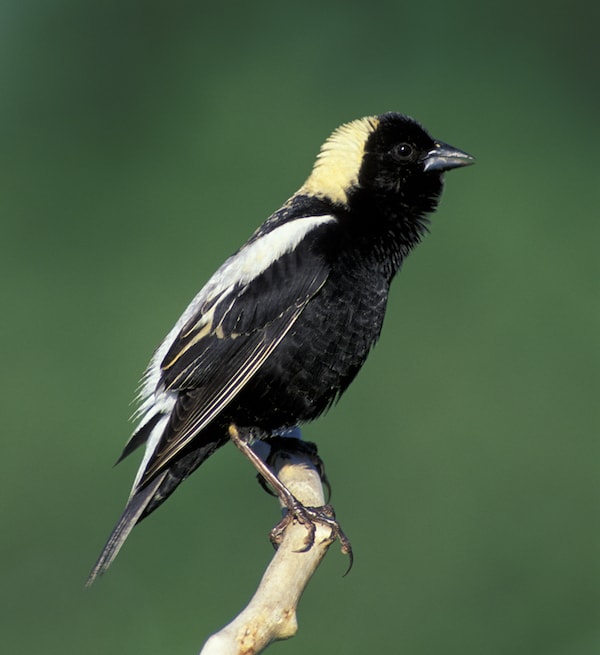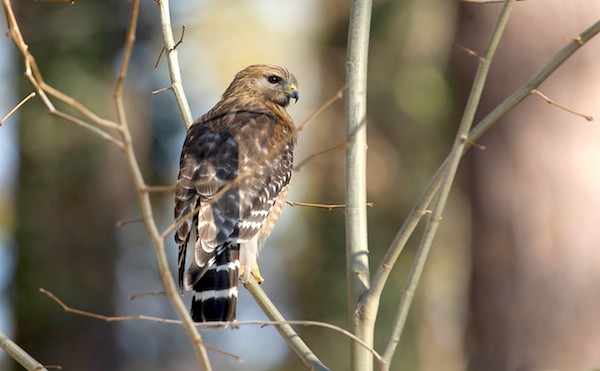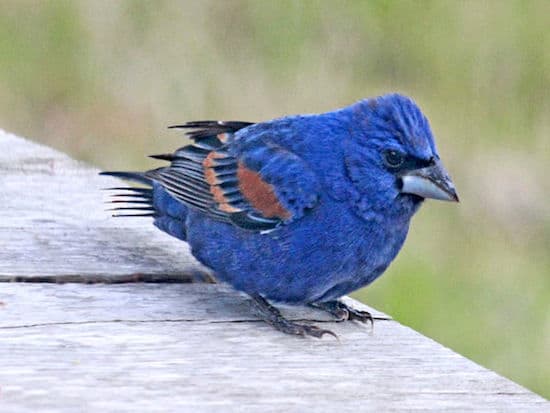1. Great Egret
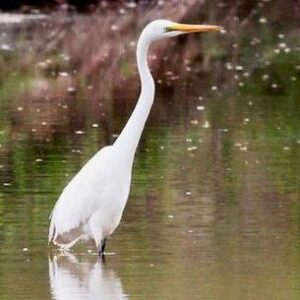
In Indiana only the great blue heron and sandhill crane stand taller than this long-necked, long-legged white bird. The little blue heron is approximately the same length and an immature little blue is also white. But the yellow bill, dark legs and feet set the great egret apart from the little blue and the smaller cattle and snowy egrets.
Stories of plume hunters decimating great and snowy egrets in their rookeries in the South particularly in Florida, and the drastic decline of the species make people think of these as southern birds. But they once nested in some numbers in rookeries along the Ohio River in southern Indiana and in the Grand Kankakee Marsh in northwest Indiana. As in the south, they declined drastically, almost disappeared, from the state. But this decline was due as much and possibly more to loss of habitat as it was to hunting. The shallow water areas where they fed were drained; trees where they nested were cut.
Great egrets have made a comeback in Indiana as well as in other states. Though not as numerous as in pioneer days, today they once more nest in a few places in the state. Almost certainly they are more widespread now than in pioneer days, because they are wanderers when not nesting and can be seen at any marsh or pond, either wading, perched in a tree, or on the shore.
Seeing a great egret in Indiana is enough of a thrill to make bird watcher and a non-birder stop for a good look. The non-birder will probably then report that he or she has seen an albino heron. Every year there seem to be more reports of great egrets in the state, and that’s a good thing for Indiana’s bird watchers.
2. Peregrine Falcon
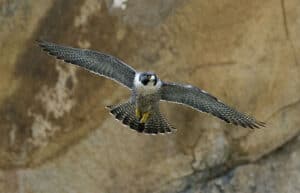
In Indiana where there are no prairie falcons, this large falcon with the dark helmet and back, spotted, almost banded lower breast and belly, is unmistakable. The peregrine is the largest falcon regularly seen in Indiana. Though a merlin resembles it, the merlin is markedly smaller, more slender and lacks the look of power of the peregrine. With just a few strokes of its long, tapered wings a peregrine falcon can reach a high rate of flight speed. When diving, or stooping, upon prey from above, peregrines, with the help of gravity, can reach speeds of up to 200 miles per hour.
Historical nesting records of peregrines in Indiana are hard to find. But it was reported regularly during migration, particularly along the shore of Lake Michigan in fall. With the extensive use of DDT following World War II, however, the peregrine disappeared from Indiana as a migrant and from the eastern half of the U.S. as a breeding bird.
Peregrines, however, have been successfully reintroduced to the state in an urban setting that, ironically, closely resembles the cliffside habitat in which peregrines normally nest. As in other states, they were released in cities after it was found they would nest on the ledges of tall buildings and prey upon starlings and pigeons. Peregrines now nest in Indianapolis and Fort Wayne and Gary and are sometimes seen, though rarely, outside the cities. Migrant peregrines are still encountered in spring and fall migration along Lake Michigan and at other sites where hawk migration is regularly monitored.
3. Sandhill Crane

The sandhill crane and great blue heron are both tall, long necked, long legged, gray birds but an adult sandhill has a red forehead, a heron has white, and an immature sandhill has a rusty head and neck. In flight a crane flies with neck extended giving it a cross shape, the heron folds its neck back and flies with its head nearly on its shoulders.
Aldo Leopold, forester, conservationist, educator and author, called the sandhill crane wilderness incarnate. Whether it‚s heard, then seen as it flies high overhead or seen feeding in a harvested grain field or standing in the shallow water of a marsh, it is an impressive symbol of wildness.
Sandhill cranes nested in the marshes of the north and northwest of Indiana in pioneer days. When those wetlands were nearly all drained, the cranes stopped nesting in the state. But they still migrated across the state, flying from nesting areas in Wisconsin and Minnesota and Canada to wintering grounds in Georgia and Florida in fall, returning north in the spring. They began using the Jasper-Pulaski State Fish and Wildlife Area in northwest Indiana as a staging area. In 1944, approximately 700 gathered there. Since then the number increased year by year until now 20,000 or more may be seen there in early November.
Sandhill cranes are also nesting once more in the north of the Hoosier State. The nests are widely scattered and not numerous but nearly every year nests are found and reported.
4. Caspian Tern
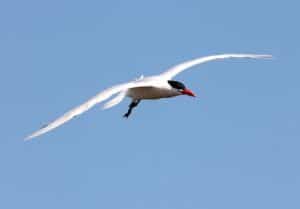
A tern is like a streamlined version of a gull, with more slender, pointed wings. The Caspian tern is a big one (21 inches long), longer than some gulls, with a proportionately larger head. It is white overall with a black cap and black wingtips and a dark-red bill with a black tip. Eastern North America’s only other large white tern, the royal tern, is smaller than the Caspian, and is rarely found inland away from salt water.
Caspian terns are migrants that go north through Indiana in spring and pass through again headed south in fall. They are seen regularly in both spring and fall along the shore of Lake Michigan. They are also seen frequently on lakes and reservoirs in the state, or along rivers, sometimes resting on a snag in the water, sometimes flying 20 or more feet above the water, then suddenly plunging in to catch a fish.
From a distance, the Caspian tern appears to be a very large white gull. Though the Caspian is a very gull-like bird, its flight style is lighter and more buoyant than a gull’s and its wings appear more angled and tapered toward the wingtips than a gull’s wings do. Gulls and terns may be seen together, loafing on a sandbar, along a dam wall, or lakeshore, so it pays to check carefully through flocks of resting gulls.
Caspian tens spend the winter months along the southern coasts of the United States.
5. Pileated woodpecker
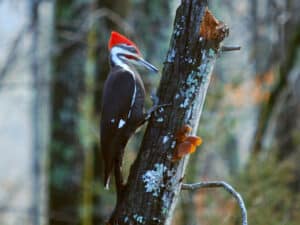
The pileated is a woodpecker that is nearly as big as a crow. It is a large, mostly black-and-white bird. Both male and female pileateds have a flaming red crest and a white stripe through the face and down the neck. Males have a red moustache on the cheek, while females show a black moustache.
When it decides to make noise the pileated woodpecker is loud. Its repetitive ack-ack-ack-ack-ack call can be heard for long distances even in thick woods. When excavating a nest hole, drilling for insect prey on a tree, or doing some territorial drumming, the pileated’s large chisel-like bill can sound exactly like an axe hitting a tree trunk. Yet, when this largest of Indiana’s woodpeckers chooses to, it can be almost silent as it swoops through the trees.
In pioneer days this bird was reported to be common in Indiana as might be expected with so much of the land being covered by deep forest. As the forests were cut the species declined until early in the last century there were suggestions that the pileated, like its relative the ivory-billed woodpecker, might become extinct. But the pileated has adapted. It has increased. Though not numerous, it is far from rare and is now found in woodlots, in residential areas and parks where there are shade trees, and in trees along streams and rivers, as well as in the remaining large forests of the state. Some backyard feeders have been visited by pileateds, often for hunks of suet or specially made bird dough.
6. Bobolink
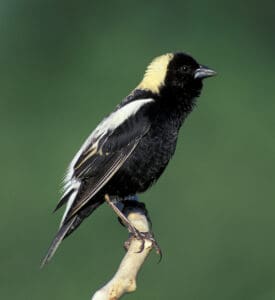
The male bobolink in breeding plumage reverses the usual color pattern birds of dark on the back, light below. The male bobolink’s face and throat are black while the back of its head is cream colored—a kind of backward tuxedo look. Its breast and belly are black, its shoulders and rump white and it has buffy steaks down its back. The female is another little brown bird, more buffy or yellow than most sparrows.
The bobolink is a bird of grassy fields and it has profited by the clearing of forest in Indiana. As fields replace forests, it became a common bird in the northern part of the state, somewhat less common in the central part. But in recent years it has declined, perhaps due to the increased use of cold-hardy hay plantings that permit earlier hay cuttings—while the bobolinks are still on the nest. Now birders take note of fields where bobolinks still nest in Indiana. These include sites where remnant prairie is preserved or where large grasslands have been left uncut, such as at Big Oaks National Wildlife Refuge near Madison in southern Indiana.
One of spring’s most beautiful sights is the fluttering flight song display of the male bobolink as he courts a female hidden in the grass and announces his “turf” to rival males. His bubbling, babbling song is spring music to the ears of bird watchers everywhere.
7. Henslow’s Sparrow
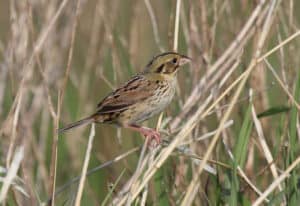
The Henslow’s sparrow is one of those irritating, intriguing little brown jobs, or LBJs. A bird of open grassland, it’s difficult to get a good look at. Often it is only glimpsed as it spurts up out of the grass, flies a short distance, and then drops back out of sight. It’s described as a large-headed sparrow with gray marks on the face and a gray stripe through the crown.
The time to see and identify a Henslow’s sparrow is in the spring and summer when it’s singing. Then it perches at the top of a stem of grass and, though its appearance is nondescript, its song is distinctive though it isn’t much of a song.
It’s an unmusical, lisping, two-note tssi-slip!, almost like a dry hiccup or the call of some insect. Bird watchers unfamiliar with this song might ignore it as insect background noise, which is certainly present in these grassland habitats. The song of the grasshopper sparrow, another of Indiana’s rare grassland nesters, is equally insect-like.
This bird is rare and local over most of Indiana. However, it is common in spring and summer in the Big Oaks National Wildlife Refuge in southeast Indiana and a significant nesting population can be found at Chinook Fish and Wildlife Area near Brazil. Many of the reclaimed strip mines in Indiana have become suitable habitat for Henslow’s sparrow and the birds seem to be thriving in these areas.
8. Black-bellied Plover
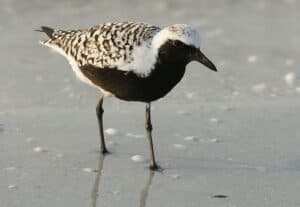
This is a chunky bird, bigger than a robin, smaller than a crow. In spring it has a black face, throat and belly, a short, thick black bill, black legs and feet, and a black back flecked with white. In flight the black-bellied plover show black “armpits” under its wings, a good field mark for identifying distant birds. Only a golden plover resembles it and the color of the golden’s back is completely different, a more golden hue.
In fall the black on a black-bellied plover is gone except for the bill, legs and feet, and replaced by mottled gray, giving the bird a much less impressive appearance than it has in spring and summer.
Bird of passage in Indiana, black-bellied plovers may be seen on the muddy shore of any lake or in a muddy farm field anywhere in the state in spring when it is migrating north or in late summer or early fall when it is on the way south. Scanning appropriate habitat during spring migration is a fruitful way to find these shorebirds. They seem to have an uncanny ability to blend into a muddy field or shoreline in spite of their large (11-1/2 inch) size. The black-bellied plover is a fairly rare sighting in Indiana, usually a single bird, though small flocks are occasionally seen along the shore of Lake Michigan during spring and fall migration.
9. Short-eared Owl

The feather tufts that give this owl the name short-eared are tiny and seldom seen, giving this bird a round-headed look, much like a barred owl. In fact, these ear tufts are usually only visible on perched birds that are alert and excited. But the short-eared has streaking around the face and on the throat instead of barring and yellow eyes, not brown which easily distinguish it from the barred. The short-eared owl is a bird of grassy, open fields, not woodlands, the preferred habitat of the barred owl.
Short-eared owls have nested in Indiana, infrequently in the past, but now they are largely erratic winter visitors. A bird watcher driving about the Indiana countryside on a cloudy day in winter may spot one, or a small loose-knit group of them, flying buoyantly as a butterfly, fairly bouncing along in the air.
Short-eared owls fly low over the ground as they hunt on the wing for mice and voles. The use both sight and sound to locate their prey, wheeling and hovering, then pouncing once an unfortunate rodent reveals its location. Walking through a grassy field, you may flush this owl, because they roost on the ground, often in a loose colony. If you flush a short-eared from its daytime roost, scan the ground for pellets. These are regurgitated balls of fur and bones, the indigestible parts of its diet.
In winter short-eared owl may skirmish with one another over prime hunting habitat. During these episodes you may hear the owl’s hoarse doglike call. The Indiana Dunes is one spot where short-eared owls may be found.
10. Cerulean warbler
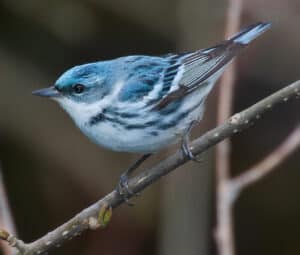
This is a treetop forager, easily heard but hard to spot among the leaves as it sings its high, buzzy song that sounds like teazel, teazel, teazel, ti ti ti zeeee. If a bright sky above doesn’t turn it into a silhouette, the male is easy to identify, blue above with a white throat and two white wing bars, white below with a blue-black necklace and streaks along the sides. The female is yellowish-green above, yellowish-gray below and lacks the necklace and streaking.
An early writer of birds in Indiana, Amos W. Butler, considered this one of the most common birds in the extensive forests of the state. Now, even where forest remains, this is an uncommon to rare spring and summer bird except in a few places, one being the Big Oaks National Wildlife Refuge north of Madison in southeast Indiana. Several population studies are ongoing all across the eastern United States seeking answers for this bird’s rapid decline.
The cerulean warbler prefers dry oak or deciduous woods for its nesting habitat. Forest fragmentation and other habitat loss both here in North America and in the Central and South American tropical forests have reduced the population of this warbler to a fraction if its original numbers. This makes this warbler species a prize find for Indiana birders and one that many birders actively seek out each spring and summer when the cerulean is in our midst. Winter finds the cerulean amid the tropical forests of Central America with no plans to return to Indiana until the following spring.

